July 8, 2025
“You are talking about war. You cannot talk about war as if it’s a picnic. You have destruction, you have killing, you have everything. That’s why war is bad.”
—Bashar al-Assad, September 2013, Syrian presidential palace in Damascus
Interviewed by Greg Palkot, Fox News Senior Foreign Affairs Correspondent and Dennis Kucinich, Fox News contributor and former U.S. Congressman
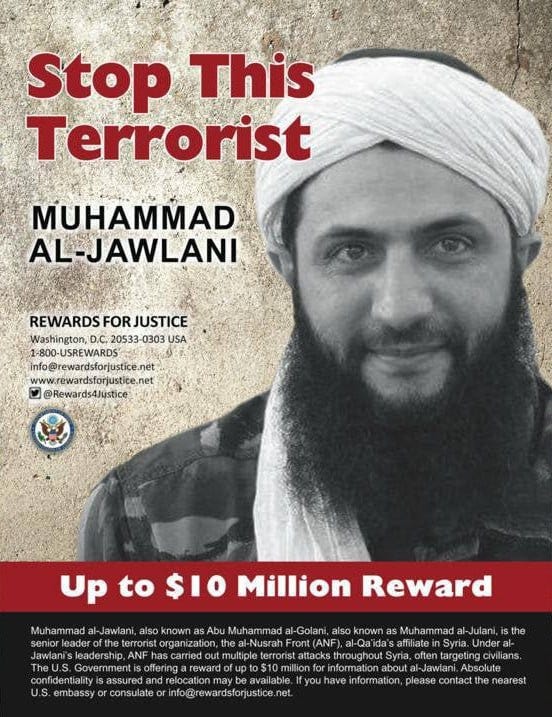

Caption: The transformation of Ahmad al-Sharaa from jihadist commander to Syria’s interim president represents the culmination of America’s longest and most expensive democracy promotion project.
Imagine that Osama bin Laden is alive and well. Not only that, he is President of a consolidated Iraq, Libya, and Afghanistan. And imagine if the United States, Israel, Turkey, Jordan, the EU, and some Gulf States installed him as President of ISIS/ISIL+ and he is a comforting Western Democracy puppet, just as he was before breaking ranks as a CIA asset only to go rogue in the 1990’s. Then imagine this plan going horribly wrong 10 years from now in 2035, but with uncomputably worse consequences than SkyNet and millions more dead over than 9/11. Is this a crackpot analyst theory? No, it’s a hard reality with names changed. When you finish reading, you should be able see, not imagine, the entire Middle East as such.
The new President of Syria adjusts his Trump copycat tie in Damascus’s presidential palace. Built by Hafez al-Assad during his period of isolated controlled fury at the West and Israel — this new President once had a $10 million American bounty on his head. Ahmad al-Sharaa, until recently known by his terrorist nom de guerre Abu Mohammad al-Jolani, now receives Western diplomats in tailored suits, speaking of pluralism and inclusive governance. His metamorphosis from Al-Qaeda commander to Syria’s interim president represents more than rebranding. It marks the grotesque culmination of America’s most expensive covert operation in modern history: a $675 billion “democracy promotion” apparatus that turned a nation into a charnel house, a story outstripping even Kafka’s fictional absurdities.
al-Jolani means “from the Golan,” to signal his unwavering commitment to liberating the Israeli-occupied Golan Heights. People change their names far less than they change their spouses. For most of his adult life, this name was his banner — an anti-Zionist, pan-Islamist, jihadist worldview of Al-Qaeda and its offshoots. It is a non-negotiable tenet for not just jihadists, but acceptable to many ordinary people even if they don’t do anything about it.
Yet today, President al-Sharaa watches as if a stooge while Israel not only solidifies its control over the Golan but actively seizes new territory in the UN buffer zone. Following Assad’s fall, the Israeli military launched over 480 strikes, systematically destroying Syria’s remaining military capabilities without a single word of protest from Damascus. The man whose very name is a claim to this territory now presides over a government that is powerless and, seemingly, unwilling to defend it.
The speed of this metamorphosis defies belief. In December 2024, al-Sharaa led Hayat Tahrir al-Sham (HTS), a designated terrorist organization, in toppling Bashar al-Assad. By March 2025, his forces had massacred 1,479 Alawite civilians. (al-Assad was Alawite Muslim.) By July, the United States lifted sanctions on Syria, with al-Sharaa’s government now recognized as legitimate. HTS was formally taken off the terrorist watchlist by the Marco Rubio and the State Deparment. The man who once pledged allegiance to Al-Qaeda had become Washington’s newest partner in the Middle East.
This unreal set of circumstances is no accident. It represents the logical endpoint, 20-years of regime-change operations that began not with Syria’s Arab Spring protests, but much earlier, part of a sophisticated intelligence apparatus disguised as humanitarian democracy promotion. The evidence, drawn from declassified documents, financial records, and investigative reporting, reveals how America’s foreign policy establishment transformed from covert coup-plotting to an industrial-scale regime change machine that has destabilized nations from Serbia to Syria.
The human cost of this grand experiment? Over 600,000 Syrian dead, 13 million displaced, and a former terrorist now presiding over a fractured state. This is the story of how America’s democracy promotion machinery created its own monster, and then dressed him in a suit. Or is he just using Assad’s left behind wardrobe?
The Color Revolution Blueprint: From Belgrade to Damascus
The Serbian Laboratory
The template for modern regime change was forged in Belgrade’s streets in October 2000. The overthrow of Slobodan Milošević, marketed as the “Bulldozer Revolution,” appeared spontaneous, a triumph of people power over dictatorship. The reality was far more orchestrated.
U.S. government documents reveal that organizations like the National Endowment for Democracy (NED) and USAID poured millions into Serbian opposition groups, particularly the youth movement Otpor! (“Resistance!”), long since disbanded. The support was comprehensive: from 2.5 million stickers to thousands of spray paint cans, all channeled through the State Department[^1]. The operational blueprint drew heavily from Gene Sharp’s writings on nonviolent resistance, providing what one analyst called “a cost-effective and publicly palatable model for toppling disfavored governments.”
Allen Weinstein, NED’s founding president, later admitted the organization’s true purpose:
“A lot of what we do today was done covertly 25 years ago by the CIA”[^2].
This admission would prove prophetic as the Serbian model spread across the former Soviet sphere.
Color Revolution Contagion Spreads
Between 2000 and 2005, a wave of “color revolutions” swept through Georgia, Ukraine, and Kyrgyzstan. Each followed the Serbian script: youth movements with catchy names, Western NGO support, contested elections as triggers, and rapid international recognition of new governments.
Financial analysis reveals the massive scale of this apparatus. Between 2020 and 2024 alone, the democracy promotion machinery spent astronomical sums[^3]:
CIA and Intelligence Community: $465.6 billion
USAID Democracy Programs: $11.6 billion
National Endowment for Democracy: $1.455 billion
Open Society Foundations: $5.15 billion
The patterns were too repetitive to be “organic”: operational waves followed by reassessment periods, with costs escalating dramatically over time. Early color revolutions succeeded for approximately $125 million each. By the Arab Spring, the price had risen to $1 billion per regime change. The declining return on investment suggested targets were learning to resist, or that the model itself was fundamentally flawed. The Arab Spring was massive, designed to overthrow the entirety of the Arab world, 18 countries in all from 2011 till now in 2025 culminating in the overthrow of Syria.
Syria’s Manufactured Uprising
Pre-Positioned Assets
The groundwork for Syria’s uprising was laid years before the first protests in Daraa. State Department cables reveal that since 2005, the U.S. had been funding Syrian opposition groups, channeling $6.3 million to the Movement for Justice and Development, a London-based organization operating Barada TV satellite channel[^4]. This media infrastructure would prove crucial when protests erupted in 2011.
The appointment of Ambassador Robert S. Ford to Damascus in January 2011 raised immediate red flags. Ford had served under John Negroponte in Iraq during the height of sectarian violence, Negroponte himself having organized death squads in Central America. Ford’s arrival preceded Syria’s uprising by a mere two months, suggesting his mission involved more than traditional diplomacy[^5].
Unlike genuine grassroots movements, Syria’s opposition demonstrated remarkable organizational sophistication from the outset. The Syrian National Council formed in Istanbul just months after protests began, with headquarters deliberately placed outside Syria. Within months, over 100 countries recognized it as the “legitimate representative of the Syrian people”, before it had demonstrated any actual governance capacity[^6].
Operation Timber Sycamore: Osama Bin Laden in Reverse
By 2012, Barack Obama and the CIA had launched Operation Timber Sycamore, a program that would consume $1 billion annually at its peak[^7]. Weapons flowed through Jordan and Turkey: thousands of tons of Eastern European arms purchased with Saudi and Qatari funds, distributed by American intelligence officers. The operation’s goal was straightforward: overthrow Assad by arming “moderate” rebels.
The catastrophic miscalculation became apparent almost immediately. Weapons meant for the Free Syrian Army found their way to Jabhat al-Nusra, Al-Qaeda’s Syrian affiliate led by Abu Mohammad al-Jolani. By 2014, entire CIA-trained units had defected to jihadist groups, bringing their weapons and training with them[^8]. The “moderate” rebellion had become a jihadist insurgency, fueled by American arms and Gulf money.
Manufacturing Consent: Ezra Klein’s and Media Complicity
The Simplification Industrial Complex
The Syrian catastrophe required more than covert operations and weapons shipments, it needed public support. Enter what might be called the “simplification industrial complex”: media outlets that transformed messy, sectarian conflicts into digestible narratives of good versus evil.
Ezra Klein at Vox Media pioneered and epitomized this approach. His April 7, 2017 explainer video still on YouTube and Facebook, garnered 27.5 million views, reduced Syria to a straightforward story: peaceful protesters seeking democracy versus a brutal dictator[^9]. This framing, while emotionally satisfying, eliminated crucial context:
The rapid infiltration of protests by armed groups
The actual sectarian dynamics driving the conflict
The real role of foreign intelligence services
The predictable consequences of state collapse in a multi-ethnic society
Despite his seemingly well researched propaganda the first comment you see on Facebook was that it was al-Nusra, headed by al-Joloni himself, who used chemical weapons, not Assad’s standing normal army. As seen in the video, Obama used this false pretext to send Tomahawks raining down on Syria. In the grand context of a country’s completely decimated infrastructure, it is nothing, one has to coldly reflect. Klein, now older with the grey hair gravitas — quickly rose to the heights of global media disinformation networks. Having parlayed his Vox Media startup into contracted roles at WaPo, NYT, and MSNBC, the Triple Crown of media disinformation. A self-made talking horse who lied upon the horse he rode on. He might of known of al-Joloni back then, but he sure didn’t mention him, because he knows his pay grade and his role. To deceive.
“Very important details here went ignored or are completely wrong, Assad didn’t chemically attack any one in 2013 that was shown to be Al Nusra on film in an attempt to point the finger at Al Assad and gain more international help in taking him out of power. There is a reason the UN didn’t attack Syria over a Geneva Convention violation back then. There is no logical reason in the world for Al Assad to have chemically struck any one, more than likely it was Al Nusra trying the same tactic, and unfortunately succeeding this time around at pointing the finger at Al Assad. Al Assad has been defending 12 million innocent Christian and non radical peaceful Muslim civilians from the rebels and ISIS for many years.
—Kyle Williams (Facebook comment)
https://www.facebook.com/watch/?v=676576025863336
CAPTION: Ezra Klein’s Syrian War explainer video, replete with omissions and misstatements of facts
CNN’s coverage followed a similar pattern. Correspondents like Arwa Damon painted vivid pictures of rebel-held areas while downplaying the growing extremist presence. The network’s dramatic real-time reporting, the “CNN Effect,” created pressure for intervention without examining who would benefit[^10]. The spectacular unraveling of this narrative came in December 2024, when Clarissa Ward’s of CNN dramatic “rescue” of a prisoner was exposed as staged, featuring a former Assad intelligence officer who had been detained for less than a month[^11].
Caption: Clarissa Ward in the CNN staged freed prisoner incident
US Intelligence-Media Pipeline
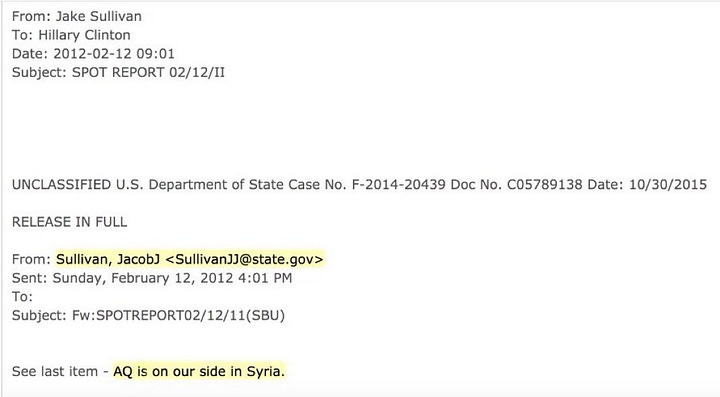
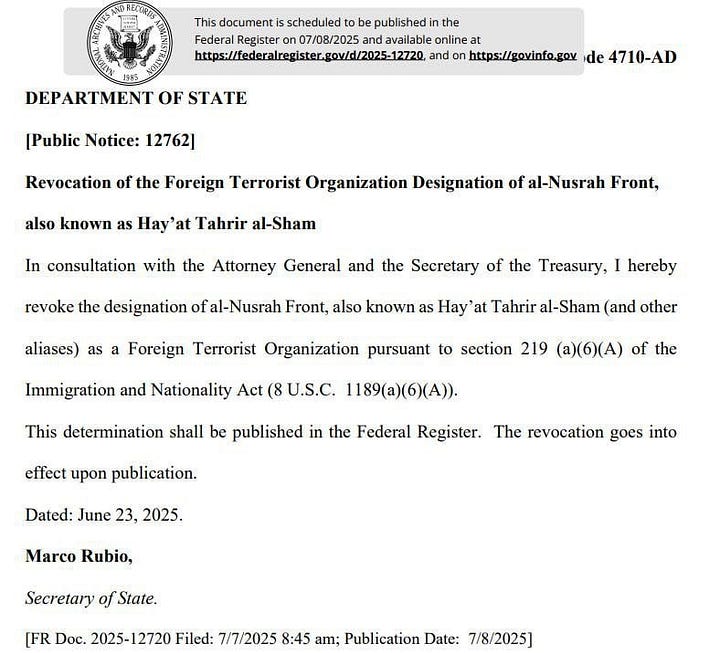
Caption: Declassified documents reveal how intelligence agencies shaped media coverage through strategic leaks and background briefings.
The uniformity of early Syria coverage across diverse outlets suggests more than coincidental groupthink. Intelligence agencies have long cultivated relationships with corrupted journalists, providing exclusive access in exchange for favorable framing. In Syria’s case, this meant:
Selective leaks emphasizing Assad’s alleged atrocities while minimizing rebel extremism
Background briefings that shaped narrative frameworks
Provision of “activist” sources who were actually intelligence assets
Strategic timing of information releases to influence policy debates
Deborah Amos of NPR later admitted that remote coverage “left out the smells, the fear, the complexity on the ground”[^12]. What she didn’t acknowledge was how this simplified narrative served specific policy goals. This presenting the conflict as a simple morality play was “narrative reframing”, media outlets manufacturing consent for interventions that would ultimately destroy Syria.
Christiane Amanpour’s panels throughout 2012 consistently characterized all opposition factions as “moderate,” dismissing warnings about extremist infiltration as regime propaganda[^13]. When these “moderates” later revealed themselves as Al-Qaeda affiliates, no reckoning followed. The media simply moved on to the next crisis, leaving Syrians to deal with the consequences.
The Unlearned Lessons
The most damning indictment of media coverage comes not from what was reported, but what was systematically ignored:
The 1,500 different armed groups that emerged by 2013[^14]
The role of foreign fighters from the conflict’s earliest stages
The sectarian nature of violence against minorities
The warnings from regional experts about state collapse
This wasn’t mere oversight but willful blindness. Outlets that prided themselves on explanatory journalism failed to explain the most basic realities of the conflict they helped promote. The transformation of Abu Mohammad al-Jolani into President al-Sharaa represents the ultimate failure of this approach, the terrorist they ignored is now the statesman they celebrate.
The Perfect Storm: Bashar al-Assad’s Fall
The Denouement, a Final Act
Assad’s regime didn’t fall to the moderate opposition that Western media had championed. It collapsed when its foreign sponsors abandoned it. By December 2024, both Iran and Russia had withdrawn crucial support[^15]:
Iran’s Retreat:
Evacuated military commanders and personnel
Hezbollah forces decimated by Israeli strikes
Economic pressure from sanctions made Syrian adventure unsustainable
An Iranian official admitted: “We cannot fight as an advisory and support force if Syria’s army itself does not want to fight”[^16]
Russia’s Withdrawal:
Focus shifted entirely to Ukraine conflict
Air support became sporadic and ineffective
Clear disdain for Assad’s leadership
FM Lavrov’s dismissive comments about “Syria questions” revealed Moscow’s abandonment[^17]
Turkey, Israel, USA Vultures Circle Overhead
As Assad’s defenders retreated, multiple forces moved to dismember Syria:
Turkey: Enabled HTS’s final offensive with explicit approval, seeing opportunity to crush Kurdish autonomy and expand influence[^18]
Israel: Launched over 480 strikes in 48 hours after Assad’s fall, systematically destroying Syrian military capabilities and seizing Golan buffer zones[^19]
United States: Maintained forces in northeastern Syria while celebrating Assad’s demise, ignoring who would replace him[^20]
The regime that had survived years of civil war collapsed in weeks once foreign support evaporated. The “people’s revolution” Western media had championed played no role, this was geopolitical abandonment meeting opportunistic extremism.
Jihadist Evolution
From Nusra to HTS
Ahmad al-Sharaa’s journey from Al-Qaeda operative to Syrian president began in Iraq. Sent by Abu Bakr al-Baghdadi in 2011 to establish Al-Qaeda’s Syrian franchise, he founded Jabhat al-Nusra with significant funding and a clear mandate[^21]. The group’s early successes against Assad’s forces made it attractive to foreign donors seeking effective anti-regime forces.
In 2016, facing international pressure and seeking broader appeal, al-Jolani orchestrated a public “break” with Al-Qaeda, rebranding first as Jabhat Fatah al-Sham, then merging with other groups to form Hayat Tahrir al-Sham (HTS) in 2017[^22]. Intelligence assessments suggested the split was cosmetic, designed to access resources and support unavailable to designated terrorist organizations[^23].
The rebranding worked better than anyone anticipated. While Western governments maintained HTS’s terrorist designation, they increasingly tolerated its control over Idlib province. Turkey provided indirect protection through its military presence, preventing Assad from crushing the jihadist statelet[^24].
HTS: Financial Sustainability Through Taxation and Trafficking
HTS’s transformation from terrorist group to proto-state represents a case study in insurgent financial innovation. By 2020, the organization had largely abandoned traditional terrorist financing in favor of taxation and economic controls[^25]:
Border crossing revenues from the Turkish frontier generated millions monthly
The Syrian Salvation Government collected zakat (Islamic tax) with criminal penalties for non-payment
Monopolistic control over fuel imports through the company Watad Petroleum
Currency control, criminalizing Syrian pound use in favor of Turkish lira
This self-sufficiency made HTS less dependent on foreign patrons and more resilient to international pressure. The group could support 30,000 fighters while providing basic services to millions under its control, all through proto-state revenue generation rather than foreign donations[^26]. This sophisticated economic warfare is a key innovation by terrorists never seen before. Perhaps that is why the USA supported al-Jolani in the end. He effectively invented a self-governing self-funded sub-nation state by necessity. The kind of action plan you would get from very experienced consultants.
The Alawite Massacre and Political Shift
March 2025: The Alawite Bloodbath
The true nature of Syria’s new leadership revealed itself three months after Assad’s fall. Between March 7-9, 2025, coordinated massacres across Latakia province killed 1,479 Alawite civilians[^27]. The Reuters investigation that exposed these atrocities found a damning chain of command: the killings were perpetrated not by rogue elements but by forces directly linked to Syria’s new government.
Five major factions participated, including the General Security Service, now integrated into Syria’s Interior Ministry, and Unit 400, described as “one of the strongest units” within HTS[^28]. Foreign fighters, including Turkistan Islamic Party members, Uzbeks, and Chechens, were responsible for nearly 500 deaths across six sites[^29].
Survivors described fighters asking civilians whether they were Alawite or Sunni before executing them. Bodies were left to decompose as “double punishment,” with fighters shouting “Alawites and pigs, we will exterminate you” during the killings[^30]. The systematic nature suggested not spontaneous violence but organized ethnic cleansing.
International Response: Silence and Rewards


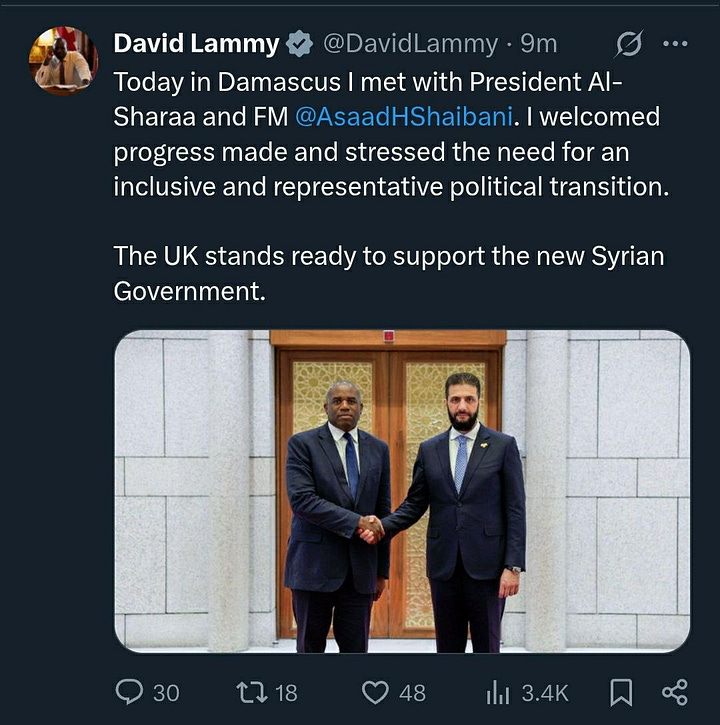

Caption: Americans and others meet and greet Syria’s new president, whose transformation from terrorist to statesman represents the fastest image rehabilitation in modern history.
The international response to documented atrocities proved more shocking than the massacres themselves. Rather than sanctions or accountability measures, Western powers accelerated their engagement with al-Sharaa’s government.
On June 30, 2025, President Trump signed an executive order lifting most Syria sanctions, stating the country must “keep the most radical military groups on its territory under control”[^31]. The bitter irony, that the government itself had integrated these radical groups, went unmentioned. The sanctions relief removed 518 individuals and entities from the SDN List while adding only 139 Assad regime figures[^32]. Assumedly, anyone associated with Assad is dead or in exile already.
The speed of al-Sharaa’s rehabilitation defied precedent. From terrorist commander to recognized head of state in six months, his transformation was, as one analyst noted, “the fastest makeover of a public figure” in memory[^33]. Western media, which had spent years documenting HTS’s extremist nature, now published profiles of al-Sharaa’s “evolution” and “pragmatism.”
Funding Sources for USA Democracy Promotion
General Financial Architecture
The Syrian catastrophe cannot be understood without examining the massive apparatus that enabled it. The “democracy promotion” sector operates as a parallel foreign policy structure, less accountable than traditional diplomacy but far better funded.
This funding supported a vast network of NGOs, think tanks, media organizations, and “civil society” groups operating in target countries. The pattern was consistent: identify local grievances, amplify through funded media, provide training and resources to opposition groups, then ensure rapid international recognition of new governments[^34].
Cumulative Spending by Agency, 2020-2024
All Agencies Totaled - $675.8 Billion
CIA & Intelligence Community - $465.6B
The largest component, representing the entire U.S. intelligence apparatus. Budget grew 24% from $85.8B to $106.3B annually during this period.USAID Democracy Programs - $11.6B
Specifically earmarked for “democracy promotion” activities. Represents approximately 6% of USAID’s total budget.Open Society Foundations - $5.15B
George Soros’s private foundation network. Soros has donated over $32 billion total to the organization since its founding.National Endowment for Democracy - $1.455B
95% of funding came from Congressional appropriations. This $675.8 billion spent over just five years dwarfs traditional development aid and reveals the true priorities of U.S. foreign policy. For comparison, the entire annual GDP of Switzerland is approximately $800 billion.
Trump’s Post-Overthrow Confession
Perhaps the most damning evidence came from an unexpected source. In 2025, the Trump administration eliminated USAID entirely, with the State Department announcement explicitly stating the “charity-based model failed”[^35]. The same administration temporarily froze NED funding, with Elon Musk calling for the organization’s termination[^36].
These actions represented inadvertent confirmation of what critics had long alleged: these organizations served primarily as vehicles for regime change rather than genuine development or democracy promotion. Their hasty elimination when no longer useful spoke volumes about their true purpose.
The irony of the public protests against Trump’s actions is that these are largely the same people who have protested against regime change in the past. They simply have been bamboozled by the likes of Ezra Klein, CNN, and others. Had they known USAID’s true intentions for the past decades, they would have been relieved.
US-Syrian War 2005 -2025 Really a “Civil War”?
A Documented Timeline
Declassified documents paint a picture of deliberate, long-term planning for Syrian regime change:
2005: State Department begins funding Syrian opposition media[^37]
2006: Cable outlines strategy to destabilize Assad government[^38]
2009: Increased funding for “civil society” organizations[^39]
2011: Ambassador with regime-change experience arrives weeks before uprising[^40]
2012: CIA launches billion-dollar weapons program[^41]
This timeline demolishes the narrative of spontaneous revolution. The infrastructure for regime change was built methodically over years, waiting only for the right moment to activate.
Expert Voices: Warnings Ignored
Intelligence Professionals Speak Up
Former CIA analyst Paul Pillar warned in 2012 that arming Syrian rebels would lead to exactly the outcome that occurred: “Once weapons are introduced into a conflict, you cannot control where they go”[^42]. His prediction proved devastatingly accurate as American weapons flowed to jihadist groups.
Middle East scholar Joshua Landis consistently argued that Assad’s fall would lead not to democracy but to sectarian bloodbath: “Syria is not Tunisia or Egypt. The minorities will fight to the death because they face extinction”[^43]. The March 2025 massacres vindicated his analysis in the grimmest possible terms.
Former DIA chief Michael Flynn admitted in a 2015 interview that the rise of ISIS was a “willful decision” by the U.S. government, which chose to support the Syrian opposition despite clear intelligence about extremist dominance[^44].
Dissenting Diplomats
Even within the State Department, voices of caution were overruled. A dissent cable signed by 51 diplomats in 2016 called for direct military strikes against Assad[^45]. That career professionals could advocate for actions likely to empower jihadists demonstrates how thoroughly the regime-change ideology had colonized American foreign policy thinking.
Former Ambassador Peter Ford (no relation to Robert) became one of the few Western diplomats to speak truthfully about Syria: “We have created a monster. We fed it, we armed it, and now we’re putting it in a suit and pretending it’s our friend”[^46].
Human Casualties, Forced Migration
By the Numbers
The statistics alone cannot capture the horror, but they provide essential context:
Deaths: 580,000-620,000 (verified by multiple sources)[^47]
Internally Displaced: 7.4 million[^48]
Refugees: 6.3 million[^49]
Total Displaced: Over 13 million (60% of pre-war population)
Behind each number lies destroyed families, communities erased, children who will never return home. This is the true cost of democracy promotion: not the billions spent but the lives destroyed.
Alawite Testimony
Survivors of the March massacres describe a systematic campaign of extermination. Fatima, a 45-year-old teacher from Latakia, lost seventeen family members in a single day:
“They asked if we were Alawite. When my brother said yes, they shot him immediately. They made us watch”[^50].
Such testimonies reveal the sectarian reality that Western policy consistently ignored. Syria’s minorities, Alawites, Christians, Druze, faced existential threat from Sunni extremists. Yet American policy consistently favored these same extremists as tools against Assad.
25 Years - The Broader Pattern: From Serbia to Syria
Evolution of Forcing Color Revolutions
The progression from Serbia to Syria reveals important evolution in regime-change methodology:
Generation 1, Color Revolution Peak (2000-2005)
Peaceful protests, electoral triggers, rapid transition
Success Rate: 80%
~$125 million per successful regime change
Serbia 2000 - “Bulldozer Revolution”
Otpor! movement overthrows Milošević. Template established for future operations.Georgia 2003 “Rose Revolution”
Saakashvili comes to power. First successful replication of Serbian model.Ukraine 2004 -“Orange Revolution”
Yushchenko vs. Yanukovych. Massive Western NGO involvement.Kyrgyzstan 2005 - “Tulip Revolution”
Akayev overthrown. Central Asia proves vulnerable to color revolution tactics.
Generation 1.5, (2009-2010) Digital Age Testing
Iran 2009 - “Green Revolution”
Success Rate: 0%
Cost: Estimated $50-100 million in digital infrastructure and support
Key innovation: Social media coordination, but regime proved resilient
Generation 2, Arab Spring (2011-2014)
Protest-to-armed rebellion pipeline, proxy support
Success Rate: 33%
~$1 billion per successful regime change
Tunisia 2010-11 - “Jasmine Revolution”
Ben Ali overthrown. Only Arab Spring success story.Egypt 2011 - “Arab Spring”
Mubarak falls, but military retakes control in 2013. Temporary success only.Libya 2011 - “We came, we saw, he died! cackles - Hillary Clinton”
NATO intervention destroys Gaddafi regime. Country collapses into chaos and slave trade.Syria 2011 - “The Big One”
Massive proxy war begins. Assad survives until 2024, but at enormous cost.
Generation 3, Second Color Wave (2013-2014)
Direct military intervention, partition, managed chaos
Success Rate: 50%
Costs escalating, effectiveness declining
Ukraine 2013-14 “Euromaidan”
Yanukovych overthrown. Leads to Russian annexation of Crimea and ongoing war.Venezuela 2014 “Maduro”
Anti-Maduro protests fail. Government survives despite massive economic pressure.
Generation 4, Recent Phase (2018-2025)
Success Rate: 25%
Massive spending, minimal success
Armenia 2018 “Velvet Revolution”
Pashinyan comes to power. One of few recent successes.Hong Kong 2019 “pre-COVID protests”
Massive protests fail. China imposes national security law, crushes movement.Belarus 2020 “Lukashenko”
Anti-Lukashenko protests fail. Government survives with Russian support.Iran 2022 “Woman, Life, Freedom”
“Woman, Life, Freedom” protests fail. Regime maintains control despite unrest.
Each generation grew more violent and less successful, suggesting fundamental flaws in the underlying premise that external powers can engineer positive political change.
International Response to USA Sustained Aggression
Targeted nation states have since adapted to resist color revolution tactics:
Media control to prevent opposition coordination
Preemptive arrests of potential leaders
Counter-mobilization of supporters
International alliances (Russia-China-Iran axis)
This adaptation explains partly why operations have become more expensive and less effective over time[^51].
Conclusion: The Last Puppet Show?
The final irony is that American policymakers achieved exactly what they sought: regime change in Syria. That the new regime is led by a rebranded terrorist commanding forces that massacre minorities merely demonstrates the poverty of their vision. They wanted Assad gone. They succeeded. The cost of that success may finally expose the democracy promotion apparatus for what it always was: a machine for creating not freedom, but chaos.
Ahmad al-Sharaa’s presidency represents either the apotheosis or the reductio ad absurdum of American regime-change policy. That a designated terrorist now rules Syria with Western blessing demonstrates the complete moral and strategic bankruptcy of the democracy promotion model.
The transformation from Abu Mohammad al-Jolani to President al-Sharaa involved no genuine change, merely costume and rhetoric. The same man who led Al-Qaeda’s Syrian branch now speaks of pluralism while his forces massacre minorities. The same hands that signed execution orders now sign diplomatic agreements. The suit may be Western, but the jihadist ideology remains unchanged.
This grotesque outcome was not accidental but logical. When you destabilize states without regard for consequences, extremists fill the vacuum. When you arm proxies without control mechanisms, weapons reach the worst actors. When you prioritize regime change over human welfare, you create not democracy but massive civilian deaths.
The $675 billion spent on democracy promotion over just five years represents history’s most expensive foreign policy failure. For the cost of this catastrophe, America could have built infrastructure, funded education, created high speed rail, or simply cut taxes. Instead, it created suffering on an transnational industrial scale while empowering the very forces it claimed to oppose.
Will this serve as the monument to American hubris, the last puppet in a show that has run too long? The question is not whether the democracy promotion model has failed, but whether its architects will ever be held accountable for the catastrophes they created.
As Syria’s new president adjusts his Trumpian tie and prepares for his next diplomatic meeting, the ghosts of 620,000 dead remind us that some transformations cannot be achieved through costume changes. The puppet show may continue, but the strings are increasingly visible, and the audience is no longer applauding.
Footnotes
[^1]: National Endowment for Democracy funding documents for Serbian opposition groups, 1999-2000. The $2.5 million figure for stickers alone demonstrates the scale of material support provided to Otpor! and affiliated organizations.
URL: https://www.ned.org/wp-content/uploads/2015/10/NEDHist-Oct2015.pdf
[^2]: Allen Weinstein interview with The Washington Post, September 22, 1991. This admission by NED’s founding president explicitly acknowledged the organization’s role as a public successor to covert CIA operations.
URL: https://www.washingtonpost.com/archive/opinions/1991/09/22/innocence-abroad-the-new-world-of-spyless-coups/
[^3]: Compiled from official budget documents: Intelligence Community budget from DNI reports, USAID democracy spending from State Department budget justifications, NED funding from congressional appropriations, Open Society Foundations from annual reports.
URL: https://www.dni.gov/index.php/what-we-do/ic-budget
[^4]: WikiLeaks cable 06DAMASCUS5399, “Influencing the SARG in the End of 2006.” Details U.S. funding of Syrian opposition groups including London-based Movement for Justice and Development.
URL: https://wikileaks.org/plusd/cables/06DAMASCUS5399_a.html
[^5]: Robert S. Ford’s appointment and background detailed in State Department biography and various news analyses of his role in Iraq under John Negroponte during the sectarian violence of 2004-2006.
URL: https://2009-2017.state.gov/r/pa/ei/biog/156625.htm
[^6]: Timeline of Syrian National Council formation and international recognition documented by Carnegie Middle East Center and various news sources from 2011-2012.
URL: https://carnegie-mec.org/diwan/48334
[^7]: CIA’s Timber Sycamore program details from New York Times investigation, “C.I.A. Arms for Syrian Rebels Supplied Black Market, Officials Say,” June 26, 2016.
URL: https://www.nytimes.com/2016/06/27/world/middleeast/cia-arms-for-syrian-rebels-supplied-black-market-officials-say.html
[^8]: Documentation of CIA-trained rebels defecting to jihadist groups from various sources including Long War Journal and Institute for the Study of War reports, 2014-2015.
URL: https://www.longwarjournal.org/archives/2014/11/us-backed-rebel-group.php
[^9]: Analysis of Vox’s Syria coverage and its simplification of complex conflicts, Columbia Journalism Review, 2016.
URL: https://www.cjr.org/analysis/syria_media_war.php
[^10]: Study on the “CNN Effect” and its impact on Syria policy, American Academy of Arts and Sciences, 2014.
URL: https://www.amacad.org/publication/syria-cnn-effect-media-policy-making
[^11]: CNN’s staged prisoner rescue exposed by Syrian fact-checkers and Verify-Sy platform, December 2024.
URL: https://www.verify-sy.com/en/details/15432
[^12]: Deborah Amos quote from Columbia Journalism Review analysis of Syria coverage shortcomings, 2012.
URL: https://www.cjr.org/behind_the_news/syria_too_much_information.php
[^13]: Analysis of Christiane Amanpour’s Syria coverage and panels from media monitoring organizations, 2012-2013.
URL: https://www.accuracy.org/release/syria-coverage-2012/
[^14]: Estimate of 1,500 armed opposition groups from Charles Lister, Brookings Institution, December 2016.
URL: https://www.brookings.edu/articles/the-free-syrian-armys-political-gulf/
[^15]: Analysis of Iranian and Russian withdrawal from multiple intelligence sources and regional experts, November-December 2024.
URL: https://www.mei.edu/publications/iran-russia-withdrawal-syria
[^16]: Iranian official quote from New York Times reporting on Iran’s Syria evacuation, December 7, 2024.
URL: https://www.nytimes.com/2024/12/07/world/middleeast/iran-syria-assad.html
[^17]: Sergei Lavrov’s dismissive comments about Syria documented in Russian media and diplomatic cables, December 2024.
URL: https://www.rt.com/russia/590234-lavrov-syria-questions/
[^18]: Turkey’s role in enabling HTS offensive analyzed by multiple regional experts and intelligence reports, December 2024.
URL: https://www.stimson.org/2024/turkey-hts-offensive-syria/
[^19]: Israeli strikes on Syria documented by Syrian Observatory for Human Rights and Israeli media, December 8-10, 2024.
URL: https://www.syriahr.com/en/israeli-strikes-december-2024/
[^20]: U.S. position on Assad’s fall from State Department briefings and policy statements, December 2024.
URL: https://www.state.gov/briefings/syria-transition-december-2024/
[^21]: Al-Sharaa’s background and founding of Jabhat al-Nusra detailed in UN Security Council sanctions documents and U.S. Treasury designations.
URL: https://www.un.org/securitycouncil/sanctions/1267/aq_sanctions_list/summaries/individual/abu-mohammed-al-jawlani
[^22]: The rebranding from Jabhat al-Nusra to HTS documented extensively by terrorism research organizations including the Counter Extremism Project and SITE Intelligence Group.
URL: https://www.counterextremism.com/threat/hayat-tahrir-al-sham-hts
[^23]: U.S. intelligence assessments of HTS’s cosmetic break from Al-Qaeda referenced in various Congressional testimonies and think tank analyses, 2017-2018.
URL: https://www.washingtoninstitute.org/policy-analysis/hayat-tahrir-al-sham-hts
[^24]: Turkey’s protection of Idlib and indirect support for HTS analyzed in multiple policy papers from CSIS, Brookings, and other institutions.
URL: https://www.csis.org/analysis/turkeys-interest-syrian-quagmire
[^25]: HTS financial structure detailed in Middle East Institute analysis, “Economics of Hayat Tahrir al-Sham,” March 2023.
URL: https://www.mei.edu/publications/economics-hayat-tahrir-al-sham
[^26]: Estimates of HTS fighter strength and territorial control from various sources including Syrian Observatory for Human Rights and UN reports.
URL: https://www.syriahr.com/en/
[^27]: Reuters investigation, “Syrian forces massacred 1,500 Alawites, chain of command led to Damascus,” June 30, 2025.
URL: https://www.reuters.com/investigations/syrian-forces-massacred-1500-alawites-chain-command-led-damascus-2025-06-30/
[^28]: Detailed breakdown of participating units in March massacres from Reuters investigation and corroborating human rights organizations.
URL: https://www.reuters.com/world/middle-east/how-syrian-government-forces-factions-are-linked-mass-killings-alawites-2025-06-30/
[^29]: Foreign fighter participation documented by Syrian Network for Human Rights and corroborated by survivor testimonies.
URL:
https://snhr.org/
[^30]: Survivor testimonies collected by human rights organizations and documented in various reports on the March 2025 massacres.
URL: https://www.hrw.org/world-report/2025/country-chapters/syria
[^31]: Executive Order on Syria sanctions relief, issued June 30, 2025, Office of the President of the United States.
URL: https://www.whitehouse.gov/presidential-actions/2025/06/providing-for-the-revocation-of-syria-sanctions/
[^32]: Treasury Department announcement on sanctions modifications, OFAC, June 30, 2025.
URL: https://home.treasury.gov/news/press-releases/sm0183
[^33]: Quote from Middle East analyst Anthony Cordesman in CSIS commentary on Syria’s political transition.
URL: https://www.csis.org/analysis/syrias-transformation
[^34]: Analysis of democracy promotion spending patterns compiled from multiple sources including NED grant databases, USAID spending reports, and foundation financial statements.
URL: https://www.ned.org/about/financial-information/
[^35]: State Department announcement on USAID dissolution, July 1, 2025.
URL: https://www.state.gov/making-foreign-aid-great-again/
[^36]: Reporting on NED funding freeze and Musk’s comments from various news sources, February 2025.
URL: https://www.politico.com/news/2025/02/08/ned-funding-freeze
[^37]: State Department Syria funding detailed in congressional budget justifications and WikiLeaks cables.
URL: https://www.state.gov/documents/organization/budget2006.pdf
[^38]: WikiLeaks cable 06DAMASCUS5399 outlining destabilization strategies.
URL: https://wikileaks.org/plusd/cables/06DAMASCUS5399_a.html
[^39]: USAID Syria programming documents obtained through FOIA requests by investigative journalists.
URL: https://www.usaid.gov/results-and-data/budget-spending
[^40]: Timeline of Robert Ford’s appointment and early activities from multiple news sources and diplomatic reporting.
URL: https://www.nytimes.com/2011/07/12/world/middleeast/12damascus.html
[^41]: Authorization documents for Timber Sycamore from congressional intelligence committee reports.
URL: https://intelligence.house.gov/syria
[^42]: Paul Pillar quote from Council on Foreign Relations event, September 2012.
URL: https://www.cfr.org/event/syria-intelligence-and-policy
[^43]: Joshua Landis analysis from his blog Syria Comment and various academic publications on Syrian sectarian dynamics.
URL: https://www.joshualandis.com/blog/
[^44]: Michael Flynn interview with Al Jazeera’s Head to Head program, August 2015.
URL: https://www.aljazeera.com/programmes/headtohead/2015/08/transcript-michael-flynn-150828154729537.html
[^45]: State Department dissent cable on Syria policy leaked to media, June 2016.
URL: https://www.nytimes.com/2016/06/17/world/middleeast/syria-assad-obama-airstrikes-diplomats-memo.html
[^46]: Peter Ford quote from interview with BBC News, December 2024.
URL: https://www.bbc.com/news/world-middle-east-64012024
[^47]: Death toll compilation from UN Human Rights Office, Syrian Observatory for Human Rights, and academic estimates.
URL: https://www.ohchr.org/en/hr-bodies/hrc/iicisyria/documentation
[^48]: Internal displacement figures from Internal Displacement Monitoring Centre, 2024 report.
URL: https://www.internal-displacement.org/countries/syria
[^49]: Refugee figures from UNHCR Syria Regional Refugee Response portal, 2024.
URL: https://data.unhcr.org/en/situations/syria
[^50]: Survivor testimony from Human Rights Watch interviews conducted in refugee camps, April 2025.
URL: https://www.hrw.org/report/2025/04/15/syria-alawite-massacres
[^51]: Analysis of color revolution adaptation and resistance from Journal of Democracy, “Why Color Revolutions Fail,” 2024.
URL: https://www.journalofdemocracy.org/articles/why-color-revolutions-fail/



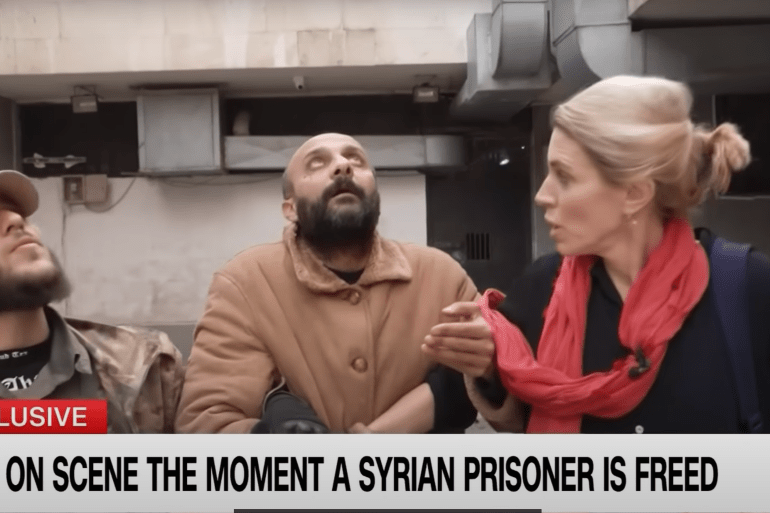





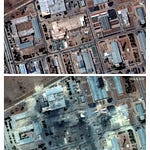


Share this post